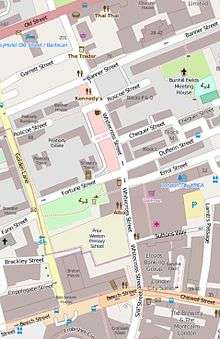Whitecross Street

Whitecross Street is a short street in Islington, in Inner London. It features an eponymous street market and a large housing estate.
Since 2010, there has been an annual Whitecross Street Party one weekend in the summer, together with an exhibition of street art.[1]
Location
The street is located in St Luke's, Islington. It runs north-south, between Old Street in the north, where it abuts St Luke Old Street, and the junction with Beech Street (west), Chiswell Street (east) and Silk Street (south, continuing the street) in the south. The southern junction marks the boundary with the City of London: Whitecross and Chiswell (north and east) are in Islington, while Beech and Silk (west and south) are in the City.
History
In his 1720 work, A Survey of the Cities of London and Westminster, John Strype wrote:
In Whitecross street, King Henry V. builded one fair House; and founded there a Brotherhood of St. Giles, to be kept. Which House, had sometime been an Hospital of the French Order, by the Name of St. Giles without Cripplegate, in the Reign of Edward I. The King having the Jurisdiction, and appointing a Custos thereof, for the Precinct of St. Giles, &c. Which Hospital being suppressed, the Lands were given to the Brotherhood, for the relief of the Poor. In this Street was a White cross; and near it was built an Arch of Stone, under which ran a Course of Water down to the Moor, called now Moorfields."[2]
Whitecross Street Market

Whitecross Street Market, having been in existence for over 150 years, is one of London's oldest markets. The market was formerly one of London's great Sunday markets, and dates to the 17th century; although today, trading is largely limited to lunch times.[3] By the end of the 19th century, the area had become a by-word for poverty and alcohol, and it became known as Squalors' Market.[4]
Today the market consists of stalls arranged along the northern half of the street, between Old Street and Fortune Street, with the road closed to traffic. There is a small general market and a food market of up to 50 food and drink vendors Monday-Friday lunchtime,[5] which can be bustling with activity (and queues) on a sunny lunch time. It has occasional food festivals.[6] In recent times, there has been significant investment from Islington Council, the City of London and English Heritage. It is open Monday–Friday, 10am–2pm.
Whitecross Street Prison
Whitecross Street Prison was a debtors' prison built 1813-15 to ease overcrowding at Newgate Prison. It had a capacity of 400 prisoners. It closed in 1870, when all of the prisoners were transferred to the newly built Holloway Prison.[7]
Other buildings

The Peabody Trust, one of London's oldest and largest housing associations, has a significant estate of social housing there, the Whitecross Street Estate.
References
| Wikimedia Commons has media related to Whitecross Street, London. |
- ↑ "Welcome To The Whitecross Street Party & The Rise Of The Non Conformists Website". Wxstreetparty. Retrieved 8 July 2014.
- ↑ "Cripplegate Ward. [The Bounds]". Hrionline. Retrieved 9 July 2014.
- ↑ London Sunday Trading in Social Investigation/Journalism - Curiosities of London Life, or Phases, Physiological and Social of the Great Metropolis, Charles Manby Smith (1853); accessed 13 April 2009
- ↑ [Squalors' Market] in Social Investigation/Journalism - Unsentimental Journeys; or Byways of the Modern Babylon, James Greenwood (1867); accessed 13 April 2009
- ↑ "Islington Street Markets". Islington Council. Retrieved 8 July 2014.
- ↑ Whitecross Street Food Festival Matthew Fort, June 23, 2007, The Guardian, accessed 10 Nov 2007
- ↑ "London Metropolitan Archives". Aim25. Retrieved 8 July 2014.
Coordinates: 51°31′22″N 0°05′34″W / 51.5229°N 0.09281°W